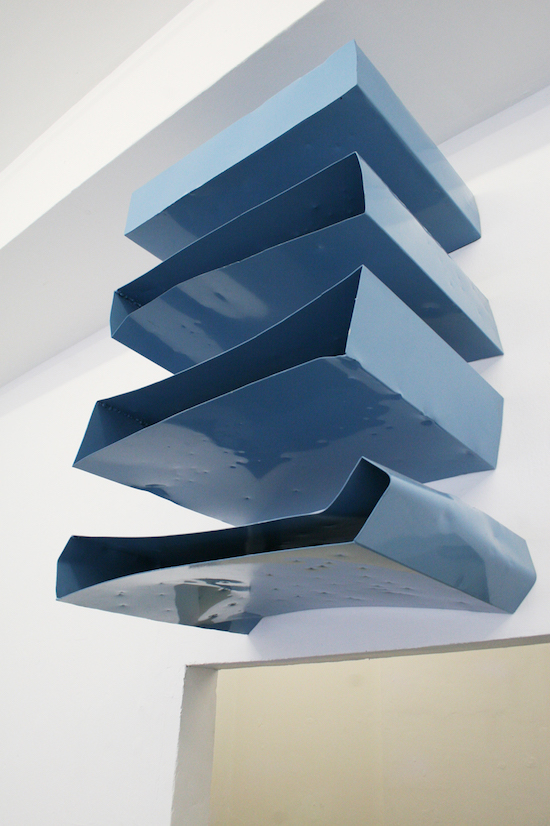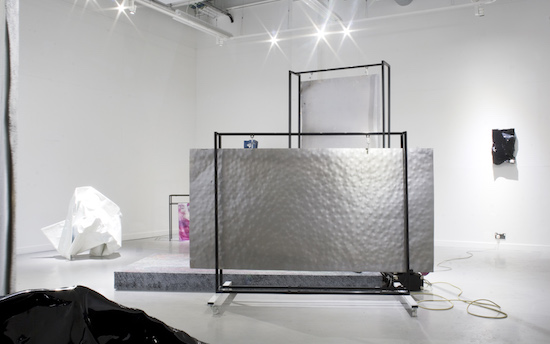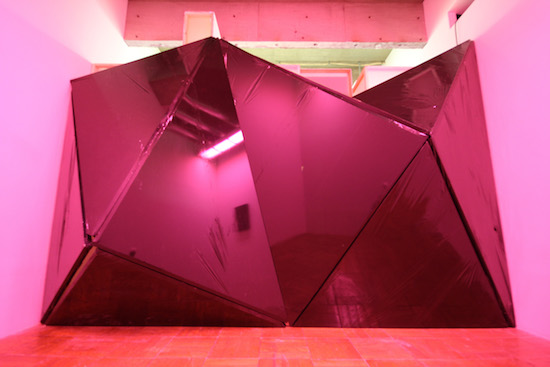It was a June day in 2012 and Cage Fighting Johnny was behind with the rent. The landlord of the part-renovated warehouse off the Fountayne Road near Seven Sisters where Johnny had been living had turned up with friends in tow and started unloading Johnny’s wares into a skip outside. Johnny, off somewhere initially at the time, got wind of the situation and turned right back up, post haste, friends of his own, all multi-coloured hair and elaborate piercings, along for back-up. What ensued resembled a bizarre kind of theatre, a ritual in which different tribes – the cage fighting punks, the orthodox Jewish landlords, the crack-smoking property guardian in the caravan in the courtyard, the congregation at the African church upstairs who would regularly get shut out of their own space and simply turn up the next day with bolt-cutters and force their way back in – all came together and faced each other down in a series of performative stand-offs without possible resolution.
Keef Winter, from his own room in the same building, several floors up, started taking pictures. It was not a question of gathering evidence or taking any side, as he would confirm to me; but a fascination with the scene itself, with the conflict between the different massed groups and the possibility of what might emerge in the interstices between them. “Someone spotted me,” he says to me, as we sit and chat in his studio off London Fields, some five years later, “and if it wasn’t for this girl who was there with them, they probably would’ve come up and beat the shit out of me. ‘He’s alright,” she said, ‘He lives here.’”
Winter had moved to the ex-industrial space in South Tottenham upon first moving to London at the beginning of that year, still in the midst of a practice-based PhD at Ulster University. “It felt like, at a certain point, this was an interesting node,” he recalls. “Like it was a meeting point for gentrification and drugs and wild free parties, mixed with people getting on with their jobs, people with big ideas, lofty ambitions to construct things, to share space.”
He started to assemble hierarchies. Hierarchies of theorised spaces – the ‘non-places’ of Marc Augé, the ‘any space whatever’ of Gilles Deleuze, the ‘other spaces’ or ‘heterotopias’ of Michel Foucault, ‘awkward spaces’, ‘spaces without function’ – and hierarchies of materials – the plywood which shutters the concrete, the concrete that supports the steel, and the steel which ultimately supports more and more high embodied energy materials like aluminium, plastics, glass, and other types of cladding.
These continua would form the basis of diagrams in a publication from the following year, I Can Be Yours on Allotrope Press, mapped against degrees of dissonance and sterility. But what, the question became, is the middle term here? What is the ground that supports the conflict between these different types of spaces and different types of material? What is made possible in their midst?
In the same year, 2013, Winter finished his PhD, a discourse on what he had taken to calling the ‘Handyman Aesthetic’, a collision of architecture, environmental psychology, urban theory, gallery aesthetics, and immediate practicality. “It was an investigation,” he says, “into what I was seeing as a resurgence of quite unfinished – or un-factory-finished – sculptural work in galleries, and also my own interest in the kind of eccentric and polarised spaces-within-spaces that I was looking at within cities.”
In the book, there are photographs of shop windows masked by a complex weave of packing tape in dense, quasi-pictorial cross-hatching; plastic sheeting draped over bike sheds; wooden sheds erected up scaffolding; dens of tarpaulin and breeze blocks in the shadow of gleaming concrete blocks. Alongside these images, there are shots of some of Winter’s work from the period: quasi-architectural forms in plastic sheeting and plasterboard, gaping holes, like punch marks, rending them apart; a found plane of corrugated metal exhibited on a wall like a portrait; fractal geometries in silvered card.

Keef Winter, ‘Jonald Dudd’, powdercoated steel, 80cm x 70cm x 50cm, Chalton Gallery, 2016
“The Handyman aesthetic began in 2010 as an exploration into the use of subordinate material, the materials of construction that hold up the more highly embodied energy materials.” Mid-century New York artists like Robert Rauschenberg, Jasper Johns, Donald Judd, and Claes Oldenburg had taken the detritus left over from Haussmannisation of New York under Robert Moses and brought it into their work, “asking the material what it’s got in it, the energy of it,” Winter says. “But at the time I was trying to get further than that. What more can we get out of this?”
The Theory of Affordances, by American psychologist James J. Gibson provided inspiration. “The affordances of the environment are what it offers to the animal,” Gibson wrote in 1979, “what it provides or furnishes, either for good or ill.” For Winter, “the theory of affordances was interesting to see what could be pulled out of space. So if you find these eccentric spaces, what can you pull out? What are the most versatile elements? They could be structural, they could be something left behind that leaves a sign, like in a detective story. What’s just happened or what is about to happen?”
Born in Northern Ireland in 1980, Winter studied architecture, first at Queens University in Belfast, later at Edinburgh College of Art. It was at the latter that he met curator Clémentine Deliss and became embroiled with her Future Academy, an experimental international research forum, and through that, met Los Angeles-based sculptor and installation artist, Oscar Tuazon, who Winter cites as one example of an artist who worked with precisely the kind of unfinished, dissonant materials that would inform certain aspects of his Handyman PhD.

Keef Winter, ‘Wrestling a great white shark’, handhammered powdercoated steel, contact microphones, speakers, H130cm x L200cm x W80cm, ‘On Becoming Fluid’ (2-person with Merike Estna), Hardwick Gallery, 2017
I first came to Winter’s studio several months ago when he was hosting a small private performance. At that time the place was crowded with a dozen or so people around its peripheries with a drum kit and two huge steel plate reverbs either side. The walls were adorned with brightly coloured boxes, hammered into irregular shapes. In a kind of preview for a later performance at Cheltenham’s Hardwick Gallery (for his show On Becoming Fluid with Merike Estna), he hammered rhythmically upon drums and steel plates, processing the sounds through a daisy chain of cheap guitar fx boxes, playing along to beats sampled from early nineties house tunes.
In other similar performances – at, for instance, Mexico City’s Galeria Breve – the brightly-painted boxes themselves have become the drum kit, their shape and form determined by the hammering action, itself determined perhaps by the rhythms and timescales of Chicago acid trax like Adonis’s ‘No Way Back’. Unlike other contemporary artists, like, say, Tarek Atoui, for whom creation of self-made instruments indistinguishable from sculpture becomes subsequently the occasion for a (musical) performance, it is here the other way round. Not the object which generates the action, but the action which generates the object.
You could relate the work, then, to the time-base theories of John Latham. The work becomes the crystallisation of the time of its production – only instead of the one second flash of a spray can’s trigger, it’s the seven minute rush of a house 12".
“I had always,” he tells me, “since 2006 maybe, always been drumming on stuff.” In that year, he conducted what he termed a ‘future tour’ around Belfast, “a fictional tour of 150 years from now, making up things about shitty little corners in the streets in Belfast. But I gave everyone sticks and I noticed that ringing these sticks along these railings of a cathedral or banging bollards, for example, you get some really nice tones, almost like a xylophone.” Shortly after he started the band Not Squares, a trio applying DIY punk attitudes to dance party vibes, who ultimately released two albums through Strange Brew Rekkids and the Richter Collective. At the same time, percussive rhythms became an increasingly important aspect of the work he was doing in sculpture and performance, inviting people to hammer at his work on opening night. “Sometimes it was musical,” he reflects, “sometimes just blatant vandalism.”
The whole process of doing that PhD, he says now, and developing the Handyman aesthetic, was comparable to “practising an instrument. It was developing a material language.” The Handyman, ultimately, is someone “brought in to do a task. You’re in to do a job, to get the job done. There was something quite romantic about that, I think, in respect to art practice and making stuff. But it’s really about how do you flip that on its head? The renegade plumber, glorified technician, daydreaming assistant. It’s kind of a subordinate role, in a way. But there’s this daydreaming potential of something more.”
Keef Winter performs at Wet & Dry Music at the Fiddler’s Elbow London NW5 on Sunday 11 June



